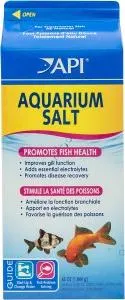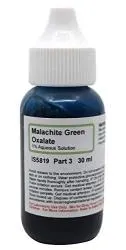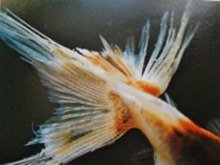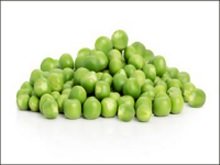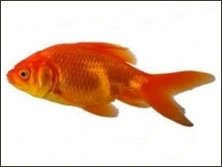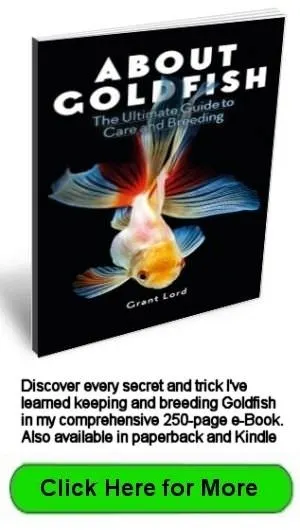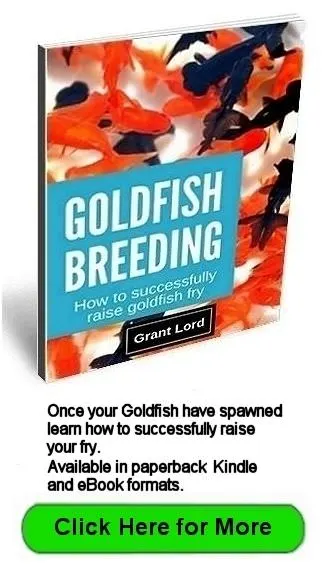- Home
- Disease Causes
- Common Goldfish Diseases
- Ich Disease
Goldfish Ich Disease (White Spot) Treatments
Ich disease (Ichthyophthirius multifiliis) or white spot disease is one of the easier Goldfish diseases to diagnose.
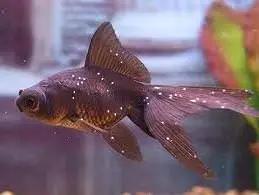 Black Moor with Ich or white spot disease
Black Moor with Ich or white spot diseaseLast Updated 06-25-2023 by Grant Lord.
Goldfish Ich disease, or as it is sometimes incorrectly called, Ick disease, is caused by a protozoan parasite. It is one of the most common parasites of aquarium fish. The parasite penetrates the skin surface of the Goldfish and feeds on its tissue and blood.
The irritation of the embedded parasite causes the epidermal (skin) cells to proliferate and form the characteristic small pinhead size white spots that appear on the fins and body. They are more easily seen on dark colored fish but are obvious when they start appearing on fins of lighter fish.
Affected fish will isolate themselves, have clamped fins and become lethargic. Most fish will develop a peppering of white spots on the body and fins. Some fish will display breathing difficulties.
A danger of this disease is it doesn't always display the characteristic white spots. It can completely encrust the gills of a fish yet the fish may not display a single white spot anywhere on its body or fins. The only indication it has the disease is an increased breathing rate.
The disease is normally considered a tropical fish disease but it is also found in the cooler water that Goldfish inhabit.
Goldfish Ich Disease Causes
Goldfish can carry Ich in small numbers without showing signs of disease or the characteristic white spots.
An outbreak of the disease is frequently caused by a sudden drop in water temperature, or poor water quality causing a weakening of the fish's immune system allowing the parasite to proliferate.
A more common cause is its introduction into the aquarium from a new arrival that hasn’t been quarantined.
Life Cycle
Ich disease has five stages in its life cycle:
- Free swimming stage, juvenile parasite looks for a host fish
- Parasite burrows into the skin of the fish which shows as a white spot
- Adult parasite leaves the host fish forming a cyst
- Reproduction of the parasite occurs by division within the cyst
- The cyst breaks to liberate thousands of juvenile parasites into the water.
The speed of this cycle depends on water temperature. At 75-79 degrees Fahrenheit (24-26 degrees Celsius) the entire life cycle is completed in about four days.
If the disease is allowed to progress too far, the white spots will start to cover the head and gill surfaces causing breathing difficulties that eventually leads to death.
Treatment Options
The infected fish cannot be treated for Ich as the parasite is embedded underneath the skin. However, the parasite can be killed once the cyst breaks releasing the juveniles into the water.
The first step in treatment is to raise the water temperature gradually into the 80s (27oC+) using an aquarium heater. This does two things:
- The temperature is too hot for Ich juveniles to survive
- It speeds up the parasite life cycle so it leaves the Goldfish quickly. Prolonged infection weakens the fish.
There are several treatments that can be used. The Goldfish should already be in a mild Aquarium Salt bath.
- Aquarium salt. The strength
needed is a 0.3% solution.
The salt is added at the rate of 3 teaspoons per gallon, the first immediately, another in twelve hours, and the last twelve hours later. Keep the fish in the solution for 14 days and then start reducing the salt at each water change.
- Methylene Blue. Three drops of 5% Methylene Blue in solution per gallon.
- Malachite Green. Most pet shops sell this chemical in convenient squeeze bottles for treating white spot. Follow the instructions from the manufacturer.
- Quinine sulfate. Dissolve ½
teaspoon per gallon. Probably the least preferred treatment option.
My preferred method of treatment is a combination of raised water temperature and a mild salt bath with Methylene Blue or Malachite Green added.
I gradually increase the salt content from one to two teaspoons per gallon. I then add the Methylene Blue or Malachite Green.
The raised water temperature should kill the juvenile cysts, the Aquarium salt will boost the fish's immune system, and the Methylene Blue or Malachite Green will stop any bacterial or fungal attack of the damaged skin of the fish, as well as killing any cysts that survive the higher water temperature.
When all cysts have disappeared after a few days, change 50% of the water without adding any chemicals. Make sure the water temperatures are the same.
Turn off the aquarium heater and keep making daily water changes until all traces of the salt and chemical are gone.
As long as the fish is active and feeding well, it can be returned to its (sterilized) aquarium once the sickbay water temperature is down to normal.
Top of Goldfish Ich Disease Treatment page
